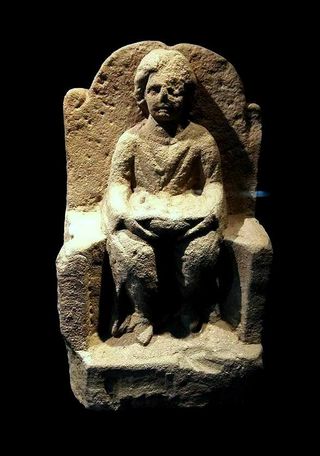「エレクラ」の版間の差分
(→語源) |
(→語源) |
||
| 12行目: | 12行目: | ||
ローマ帝国の碑文で通常使用される古典ラテン語の大文字では、頭文字のHとAの形が似ており<ref>Green (2004), pp. 120–121.</ref>、特にローマ帝国の社会では識字率が低く、ある文字の音素値を誤認することがあったからであろう<ref>This is also apparent in the inscriptions to Belatucadrus. Green (2004), p. 102.</ref>。Aeraecura ~ Aerecura ~ Aericura ~ Eracura ~ Ercura ~ Erecura ~ Heracura ~ Herecura ~ Herequraの交代の背景には、*/aireˈkura/または*/(h)eːreˈkura/という形の名称があるようだ。 | ローマ帝国の碑文で通常使用される古典ラテン語の大文字では、頭文字のHとAの形が似ており<ref>Green (2004), pp. 120–121.</ref>、特にローマ帝国の社会では識字率が低く、ある文字の音素値を誤認することがあったからであろう<ref>This is also apparent in the inscriptions to Belatucadrus. Green (2004), p. 102.</ref>。Aeraecura ~ Aerecura ~ Aericura ~ Eracura ~ Ercura ~ Erecura ~ Heracura ~ Herecura ~ Herequraの交代の背景には、*/aireˈkura/または*/(h)eːreˈkura/という形の名称があるようだ。 | ||
| − | 女神自体はケルトの女神かもしれないが、その名前がケルト語起源なのか、あるいはインド・ヨーロッパ語起源なのか、疑問の余地がある。レンダリング(Lendering)は、彼女の教団はイリュリア<ref>バルカン半島の西部地方</ref> | + | 女神自体はケルトの女神かもしれないが、その名前がケルト語起源なのか、あるいはインド・ヨーロッパ語起源なのか、疑問の余地がある。レンダリング(Lendering)は、彼女の教団はイリュリア<ref>バルカン半島の西部地方</ref>起源で、アクイレイアから広がり、そこに配置されたローマ軍を通じてドナウとレーナの国境地帯に到達したと考えている<ref name="lendering">https://www.livius.org/religion/herecura/, Jona Lendering, Herecura, Livius.org, 2015-05-28, 2014</ref>。 |
| 20行目: | 20行目: | ||
| − | Though the goddess herself may be [[Celtic polytheism|Celtic]], it is open to question whether the name is of [[Celtic languages|Celtic origin]] or even [[Indo-European languages|Indo-European]]. Lendering considers her cult to be of [[Illyria]]n origin, spreading from [[Aquileia]] and only reaching the Danubian and Rhenish border regions through the Roman troops deployed there. | + | Though the goddess herself may be [[Celtic polytheism|Celtic]], it is open to question whether the name is of [[Celtic languages|Celtic origin]] or even [[Indo-European languages|Indo-European]]. Lendering considers her cult to be of [[Illyria]]n origin, spreading from [[Aquileia]] and only reaching the Danubian and Rhenish border regions through the Roman troops deployed there. Beck considers the name to be of Germanic origin.<ref name="beck135">[[#beck|Beck]] (2009), p. 135.</ref> |
==Bibliography== | ==Bibliography== | ||
2022年11月24日 (木) 18:39時点における版
エレクラ(Erecura または Aerecura、/ɛrɪ (Herecura または Eracura とも))[1]は古代に崇拝された女神で、しばしばケルト人由来と考えられており、主にプロセルピナのように表され、スルツバッハの祭壇に見られるようにローマの地下世界の神ディス・ピター(Dis Pater)と関連付けられている[2]。エレクラはスイスのオーバーゼーバッハで発見された像や、オーストリアのいくつかの魔術書にディス・パテルとともに登場し、ケルベロスとともに、またオグミオスとともに登場することもあるようだ[3]。また、ドイツのシュトゥットガルトの近くでも、彼女への碑文が発見されている。神々の象徴のほか、豊穣の象徴であるコルヌコピアやリンゴの籠などとともに描かれることが多い[4]。エレクラはギリシャ神話のヘカテーに似ているとされ、2人の女神の名前も似ている[5]。エレクラはカンシュタット[6]やスルツバッハ[2]で描かれた作品では、フルローブを着て果物の入った盆や籠を持ち、座った姿勢で描かれている。ミランダ・グリーンはエレクラを「ガリア人のヘクバ」と呼び[7]、ノエミー・ベックは彼女をディス・パテルと同じ冥界と豊穣の側面を持つ「地下世界の女神」として特徴づけている[8]。
エレクラの名は、南ドイツやスロベニアのドナウ地方に多く見られるが、イタリア、イギリス、フランスにもある。彼女の碑文は、シュトゥットガルト[9]とライン川沿いに集中している。エレクラを称える石碑は、墓地やその他の葬儀の場にもいくつか見られる[10]。ヨナ・レンダリング(Jona Lendering)はエレクラの図像がゲルマニア・インフェリオールで崇拝されていたネヘレニアとの類似性を指摘し[4]、ベックは彼女の属性とマトレやマトロネとの間に大きな相違はないと見ている。地理的には、エレクラとディス・パテルが祀られていた地域は、スケッルスとナントスエルタが祀られていた地域と相補的な分布にあり、ベックは、これらの信仰は図像的には異なるが機能的には類似していたと示唆する[10]。
イングランドのノーサンバーランドにある祭壇石には、アレクリウス(Arecurius)またはアエリクルス(Aericurus)と呼ばれる男性神の名前があるが[11]、ベックは「この碑文はかなり不確かで、メルクリオ(Mercurio)の誤読かもしれない」と注意を促している[6]。
語源
エレクラの名称の由来は不明である。ラテン語のaes、aeris「銅、青銅、お金、富」、era「愛人」、ギリシャ神話の女神ヘーラーの名前と関係があるとされている。この女神の名前には、ラテン語化されたさまざまな形がある[12]。ペルージャのAeraecura、マインツ、ザンテン、アクイレイア、ロシア・モンタナのAerecura、シュルツバッハ(マルシェ)のAericura、オーストリア・マウテルンのEracura、フリエブルグのErcura、カンシュタット、アウベのベレイのErecura、シュトックシュタット・アム・ライン、カンシュタット、フラインスハイム、ネッカー・ロッテンブルクのHerequraなどである[13]。
ローマ帝国の碑文で通常使用される古典ラテン語の大文字では、頭文字のHとAの形が似ており[14]、特にローマ帝国の社会では識字率が低く、ある文字の音素値を誤認することがあったからであろう[15]。Aeraecura ~ Aerecura ~ Aericura ~ Eracura ~ Ercura ~ Erecura ~ Heracura ~ Herecura ~ Herequraの交代の背景には、*/aireˈkura/または*/(h)eːreˈkura/という形の名称があるようだ。
女神自体はケルトの女神かもしれないが、その名前がケルト語起源なのか、あるいはインド・ヨーロッパ語起源なのか、疑問の余地がある。レンダリング(Lendering)は、彼女の教団はイリュリア[16]起源で、アクイレイアから広がり、そこに配置されたローマ軍を通じてドナウとレーナの国境地帯に到達したと考えている[4]。
Though the goddess herself may be Celtic, it is open to question whether the name is of Celtic origin or even Indo-European. Lendering considers her cult to be of Illyrian origin, spreading from Aquileia and only reaching the Danubian and Rhenish border regions through the Roman troops deployed there. Beck considers the name to be of Germanic origin.[6]
Bibliography
References
- テンプレート:Anchor テンプレート:Cite thesis
- Ellis, Peter Berresford, Dictionary of Celtic Mythology (Oxford Paperback Reference), Oxford University Press, (1994): ISBN 0-19-508961-8
- テンプレート:Anchor Egger, Rudolf. Römische Antike und frühes Christentum: Ausgewählte Schriften von Rudolf Egger; Zur Vollendung seines 80. Lebensjahres, ed. Artur Betz and Gotbert Moro. 2 vols. Klagenfurt: Verlag des Geschichtsvereines für Kärnten, 1962–63. (LOC call number DB29.E29.)
- テンプレート:Anchor Green, Miranda (2004). The gods of the Celts. Sparkford, UK: Sutton Publishing.
- MacKillop, James. Dictionary of Celtic Mythology. Oxford: Oxford University Press, 1998. ISBN 0-19-280120-1.
- Wood, Juliette, The Celts: Life, Myth, and Art, Thorsons Publishers (2002): ISBN 0-00-764059-5
External links
関連項目
- 黄金の林檎:女神の持つ重要なアイテムである。
参照
- ↑ Nicole Jufer & Thierry Luginbühl. Les dieux gaulois : répertoire des noms de divinités celtiques connus par l'épigraphie, les textes antiques et la toponymie. Paris: Editions Errance, 2001., ISBN:2-87772-200-7. pp. 18, 40, 45.
- ↑ 2.0 2.1 Beck(2009), p. 136.
- ↑ Egger (1962-63), I.84-85; I.276-79; II.24-33.
- ↑ 4.0 4.1 4.2 https://www.livius.org/religion/herecura/, Jona Lendering, Herecura, Livius.org, 2015-05-28, 2014
- ↑ P. Monaghan The Encyclopedia of Celtic Mythology and Folklore New York: Facts On File, Inc, 2004. ISBN:0-8160-4524-0, p. 4.
- ↑ 6.0 6.1 6.2 Beck (2009), p. 135.
- ↑ Green (2004), p. 124.
- ↑ Green (2004), p. 124.
- ↑ ドイツの都市
- ↑ 10.0 10.1 Beck (2009), p. 137.
- ↑ R.G. Collingwood and R.P. Wright. The Roman Inscriptions of Britain (RIB), Vol. 1: The Inscriptions on Stone. RIB 1123. See also the relevant page of roman-britain.org , https://web.archive.org/web/20060820145944/http://www.roman-britain.org/places/corstopitum.htm, August 20, 2006 .
- ↑ Egger (1962), I.84-85.
- ↑ Lajoye, Patrice; Inventaire des divinités celtiques de l’Antiquité, Caen: Société de Mythologie Française. Available at L’Arbre Celtique.
- ↑ Green (2004), pp. 120–121.
- ↑ This is also apparent in the inscriptions to Belatucadrus. Green (2004), p. 102.
- ↑ バルカン半島の西部地方

